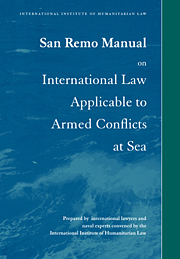 San Remo Manual on International Law Applicable to Armed Conflicts at Sea
San Remo Manual on International Law Applicable to Armed Conflicts at Sea Book contents
- Frontmatter
- Contents
- FOREWORD
- SAN REMO MANUAL
- EXPLANATION
- Introduction
- List of abbreviations
- Part I General provisions
- Part II Regions of operations
- Part III Basic rules and target discrimination
- Part IV Methods and means of warfare at sea
- Part V Measures short of attack: interception, visit, search, diversion and capture
- Part VI Protected persons, medical transports and medical aircraft
- INDEX
Part VI - Protected persons, medical transports and medical aircraft
Published online by Cambridge University Press: 04 August 2010
- Frontmatter
- Contents
- FOREWORD
- SAN REMO MANUAL
- EXPLANATION
- Introduction
- List of abbreviations
- Part I General provisions
- Part II Regions of operations
- Part III Basic rules and target discrimination
- Part IV Methods and means of warfare at sea
- Part V Measures short of attack: interception, visit, search, diversion and capture
- Part VI Protected persons, medical transports and medical aircraft
- INDEX
Summary
General rules
159 Except as provided for in paragraph 171, the provisions of this Part are not to be construed as in any way departing from the provisions of the Second Geneva Convention of 1949 and Additional Protocol I of 1977 which contain detailed rules for the treatment of the wounded, sick and shipwrecked and for medical transports.
159.1 The Round Table decided not to introduce into this document all the detailed provisions on the protection of the wounded, sick and shipwrecked that are to be found in the Second Geneva Convention of 1949 and Additional Protocol I. This document concentrates on the law applicable to the conduct of hostilities at sea as this is the area that has been the subject of the greatest uncertainty. The law applicable to the protection of the wounded, sick and shipwrecked at sea, however, is still governed by the Second Geneva Convention and Additional Protocol I and the rules therein are sufficiently clear. The provisions in Part VI of this document are therefore to be seen as additional to these treaty law provisions or as a clarification. The only exception to this is paragraph 171 which recommends a rule which is at variance with the Second Geneva Convention.
160 The parties to the conflict may agree, for humanitarian purposes, to create a zone in a defined area of the sea in which only activities consistent with those humanitarian purposes are permitted.
160.1 This paragraph is inspired by the ‘Red Cross Box’ that was agreed on by Argentina and the United Kingdom during the South Atlantic conflict in 1982.
- Type
- Chapter
- Information
- San Remo Manual on International Law Applicable to Armed Conflicts at SeaInternational Institute of Humanitarian Law, pp. 223 - 246Publisher: Cambridge University PressPrint publication year: 1995


